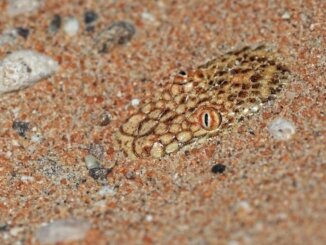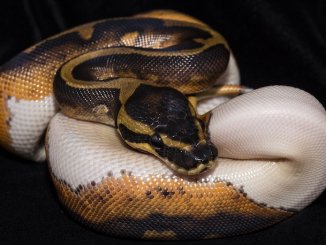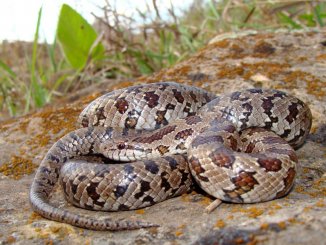The blunt-headed tree snake is a slim, pale brown, mildly-venomous snake hailing from South America, Central America, and Mexico.
This species is one of the easiest tree-dwelling snakes to care for in captivity. However, the snake isn’t recommended for beginners because most specimens are wild-caught and have specific dietary requirements.
Blunt-Headed Tree Snake Overview
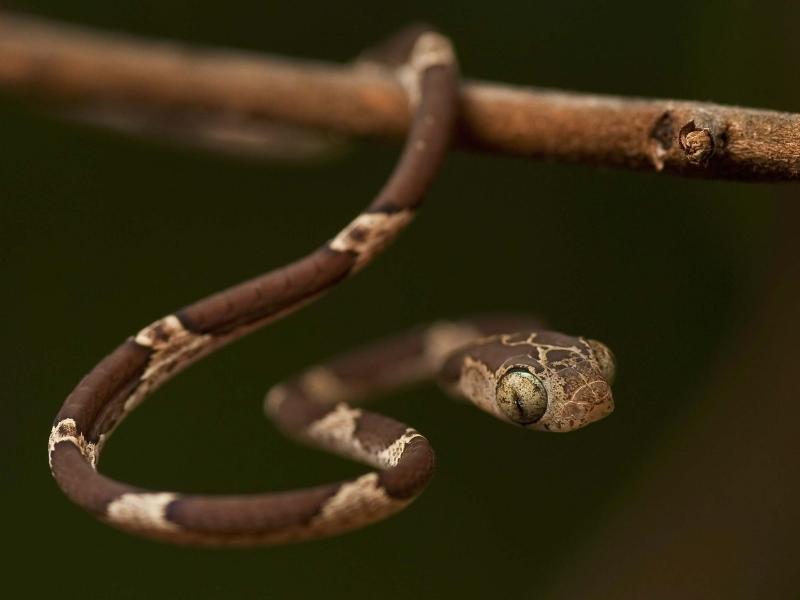
| Common name | Blunt-headed tree snake, blunthead tree snake, fiddle-string snake, mapepire corde violon |
| Scientific name | Imantodes cenchoa |
| Natural habitat | Dense, low vegetation in moist environments like rainforests, in Mexico, Central America, and South America |
| Adult size | 30–35 inches |
| Average lifespan | Around 10 years |
| Diet | Carnivore |
| Housing | Minimum 40 gallons, 70–89°F, 75%–85% humidity |
| Experience level | Intermediate |
Origin
The blunt-headed tree snake (Imantodes cenchoa) originates in Mexico, Central America, and South America. The snake is widely distributed in the wild and frequents dense, low vegetation in moist habitats like rainforests.
Blunt-headed tree snakes are arboreal, meaning that they spend most of their lives in trees and have an enlarged middorsal scale row that provides stability when climbing. The snakes are mildly venomous, using their venom to subdue fast-moving prey.
Appearance and Behavior
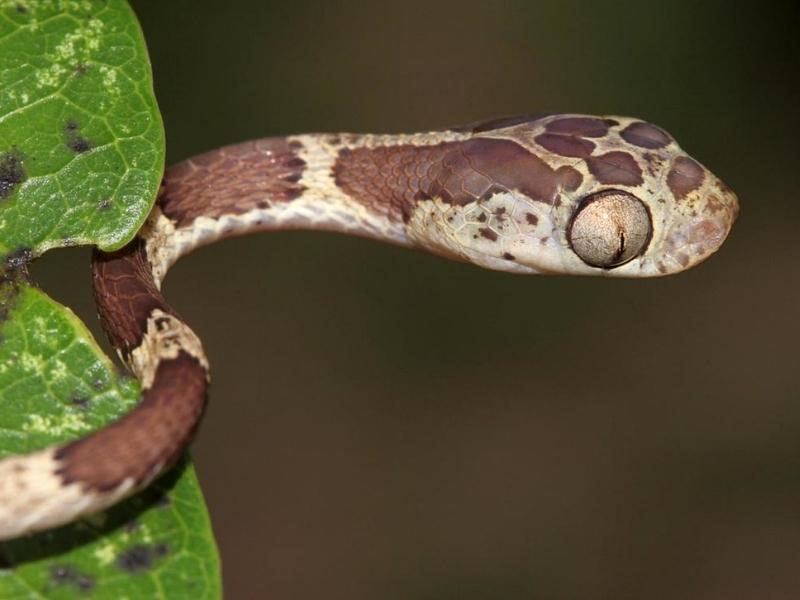
The blunt-headed tree snake has a long, slim body and a large, short, head that ends in a blunted point. This snake has large eyes that take up more than a quarter of its head, and vertical slits for pupils that allow it to look downward.
The stomach (or ventral surface) of the blunt-headed tree snake is pale, while the top (or dorsal surface) is pale brown, with between 30 and 60 patches of dark brown that span from the head to the tail.
The snake’s exact origin affects the sexual dimorphism exhibited in males and females. In northern blunt-headed tree snakes, males have longer tails than females. In southern snakes, males have shorter tails than females.
Size and Lifespan
The average length of a blunt-headed tree snake is 30–35 inches, and the maximum total length is 4 feet 11 inches.
Blunt-headed tree snakes have an unknown lifespan, but the estimated lifespan for a snake in the wild is between 6 and 10 years.
Temperament
The blunt-headed tree snake is a docile, solitary species that prefer to be housed alone. The snake enjoys climbing and exploring from a height. Many blunt-headed tree snakes are wild-caught and find adapting to captivity stressful. Handling the snake isn’t advised because it becomes stressed easily and may bite.
Blunt-headed tree snakes are nocturnal, meaning that they’re most active at night, and spend most of the day in a coiled resting position in shaded areas.
Housing Blunt-Headed Tree Snakes
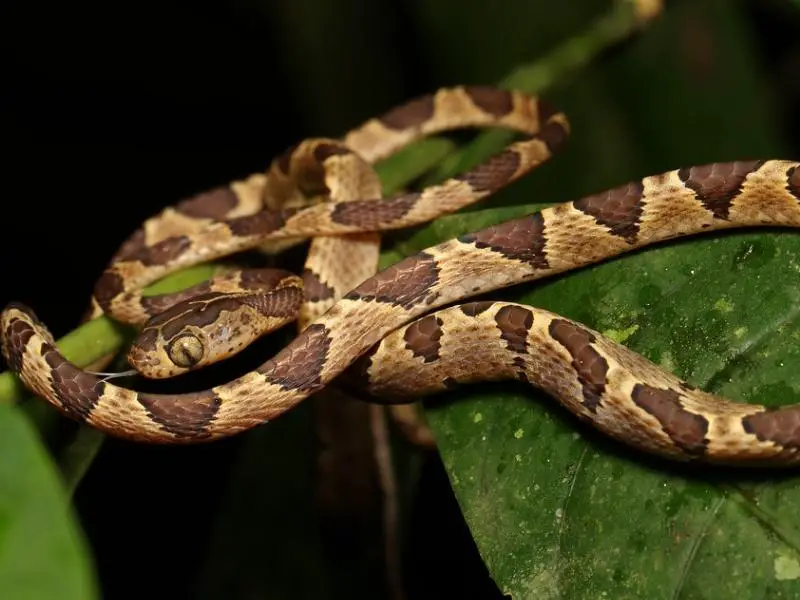
The blunt-headed tree snake’s natural habitat is densely vegetated rainforests in and around South America. Replicate the snake’s environment as closely as possible in the enclosure to ensure the snake feels comfortable in captivity.
Keep blunt-headed tree snakes in a well-ventilated wooden vivarium, which holds onto heat better than other enclosure materials.
Enclosure size
The ideal size for a blunt-headed tree snake enclosure is at least 40 gallons. The snake likes to climb, so the enclosure should be at least 24 inches high. The depth and width of the tank should both be a minimum of 15 inches.
Lighting
Blunt-headed tree snakes spend most of their time in the shade and are most active at night, so they don’t rely on UVB light from the sun for calcium absorption. No special lighting is needed for the snake in captivity.
Place the enclosure in a room with a window, giving at least eight hours of access to daylight per day, so that the snake can differentiate between day and night.
Temperature and Humidity
Blunt-headed snakes can’t produce their own body heat and rely on their environment to thermoregulate. Not much is known about the exact temperature and humidity requirements for this snake, but it’s likely that the species requires the same climate as other arboreal snakes from the South American rainforest.
Set up two separate areas in the tank. One area should be for basking, with a temperature of between 85 and 89°F. Use a basking lamp to increase the temperature of the basking area, and switch the lamp off at night to stimulate the cool evening temperatures after sunset.
The other area in the tank should be the cool end, with a temperature of between 70 and 75°F. Use a thermometer to monitor the temperature and reduce the temperature to 65°F overnight.
The ideal humidity for a blunt-headed tree snake enclosure is between 75% and 85%, to mimic the damp, humid climate that the snake is used to in the wild and assist the snake with shedding. Use a hygrometer to monitor humidity. If humidity levels are too low, spray the enclosure several times a day with room-temperature water.
Substrate and Decoration
Suitable substrates for a blunt-headed tree snake enclosure include soft substrates that retain humidity, like aspen bedding and Cypress mulch. The blunt-headed tree snake spends most of its time climbing, but ventures down to the ground to drink. The substrate should be non-abrasive to prevent damage to the snake’s skin.
The most important decorations in an enclosure for this snake species are branches. Blunt-headed tree snakes climb small trees in the wild, so the enclosure should have at least two large, intersecting branches that span from the bottom corners to the opposite top corners.
Artificial greenery, reptile vines, spider plants, or jade plants provide shaded spots for the snake to sleep and mimic the dense jungle environment in the snake’s wild habitat. Rocks and caves can be added to the enclosure to give a natural feel.
Cleaning
A blunt-headed tree snake’s enclosure should be spot-cleaned once a day and deep-cleaned at least once a week.
To spot-clean, the enclosure, scoop up leftover food and soiled substrate and add fresh substrate to the spot-cleaned areas. Remove and wash out the water bowl, and refill it with fresh water.
Deep-cleaning an enclosure requires access to the entire tank. Carefully transport the snake to a temporary enclosure, using snake-handling tongs if necessary. Empty the tank and dispose of the old substrate. Wipe down the plants and soak the decorations in warm, soapy water. Dip a sponge in water mixed with dish soap and scrub the insides of the tank.
Once you’re done, dry the enclosure and add a fresh layer of the substrate to the bottom. Return the clean plants and decorations and then return the snake.
Never use chemical cleaners that could cause respiratory issues in the snake. For tough stains, a solution of equal parts water and white vinegar is effective.
Blunt-Headed Tree Snake Care
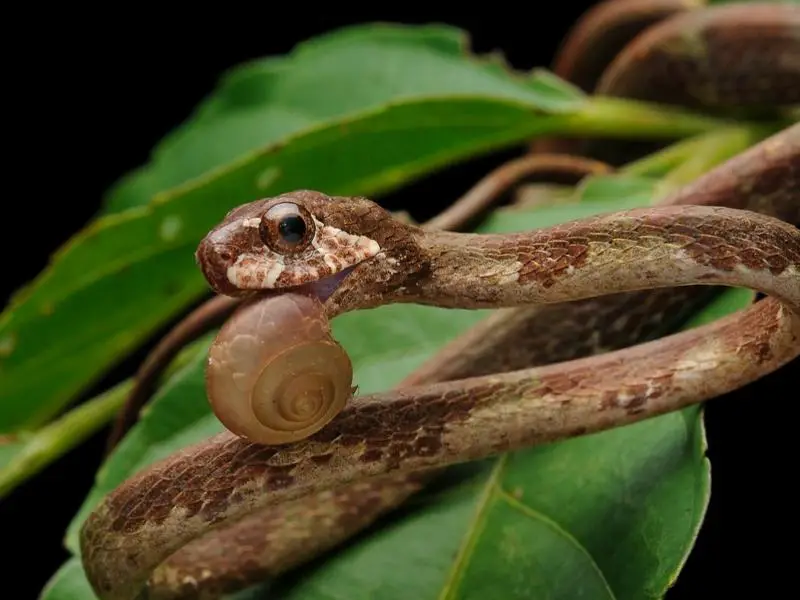
Blunt-headed tree snakes have specific dietary requirements, get stressed easily, and are difficult to look after in captivity.
Food and Water
In the wild, the blunt-headed tree snake’s diet consists of amphibians and young lizards. Replicate this diet in captivity. Feed the snake feeder geckos and anoles every ten days, offering enough food for the snake to eat within 20 minutes.
Feed juvenile snakes a diet of small lizards, super worms, and Dubia roaches once every seven days.
Blunt-headed tree snakes have thinner necks than most other snakes, so you shouldn’t attempt to feed them rats or mice.
This snake species needs constant access to a clean water supply. Consider installing a water bowl mid-way up the wall of the enclosure to allow the snake to drink water from a height. If an elevated water bowl isn’t possible in your tank setup, a water bowl on the floor of the enclosure is fine.
Handling
Most blunt-headed tree snakes are collected from the wild, so they’re not tame or used to human interaction. The snakes become stressed when they’re handled, so you should only handle them when it’s essential, such as during enclosure relocations and health checks.
Common Health Issues
Not much is known about the potential health issues that a captive blunt-headed tree snake is prone to. It’s likely that the snake is affected by common health problems that affect all snakes housed in warm, humid enclosures — such as mites and respiratory infections.
Mites
Mites are tiny black parasites that can be transferred into a snake enclosure through infested foods or other animals. Mites lay their eggs in the substrate and latch onto a snake’s skin, feeding on its blood. To treat snake mites, bathe the snake in warm water or use an over-the-counter reptile lice treatment. Disinfect the enclosure thoroughly to eliminate the mites and prevent them from returning.
Respiratory Problems
Suboptimal temperatures in the snake’s enclosure cause respiratory problems like pneumonia. Open-mouthed breathing, wheezing, and difficulty breathing are symptoms of respiratory problems according to the VCA. Treat the infection by optimizing the temperature in the enclosure. If the problem doesn’t clear after one or two weeks, consult a reptile veterinarian.
Breeding
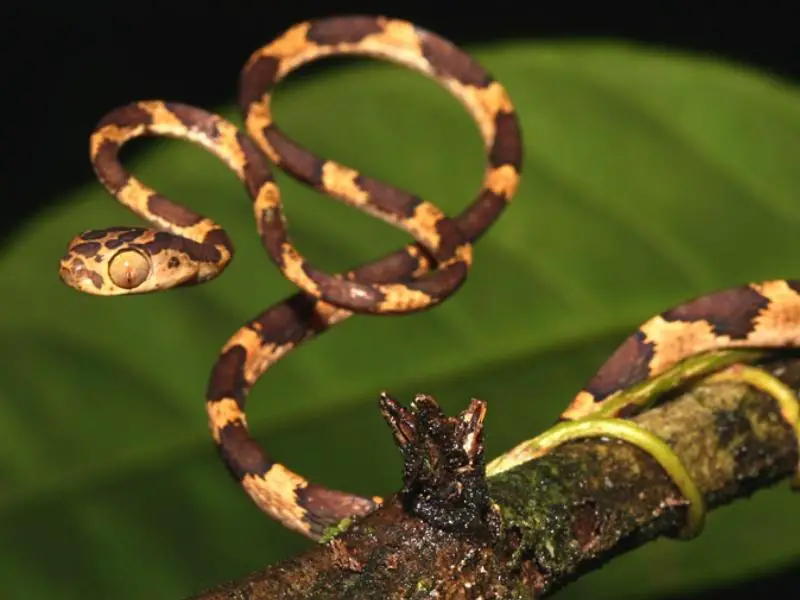
In the wild, blunt-headed tree snakes breed during the rainy season. The snakes reach sexual maturity at about two years old. After breeding, the females lay their eggs on the forest floor, and the eggs typically hatch between March and August.
Information on breeding blunt-headed tree snakes in captivity is limited because the snakes are so rarely sold as pets. Finding healthy and willing males and females, and stimulating the rainy season in the enclosure, is difficult.
Most experts haven’t had the opportunity to attempt breeding, and it’s highly unlikely that hobbyist snake keepers would successfully breed these snakes.
Choosing and Buying a Blunt-Headed Tree Snake
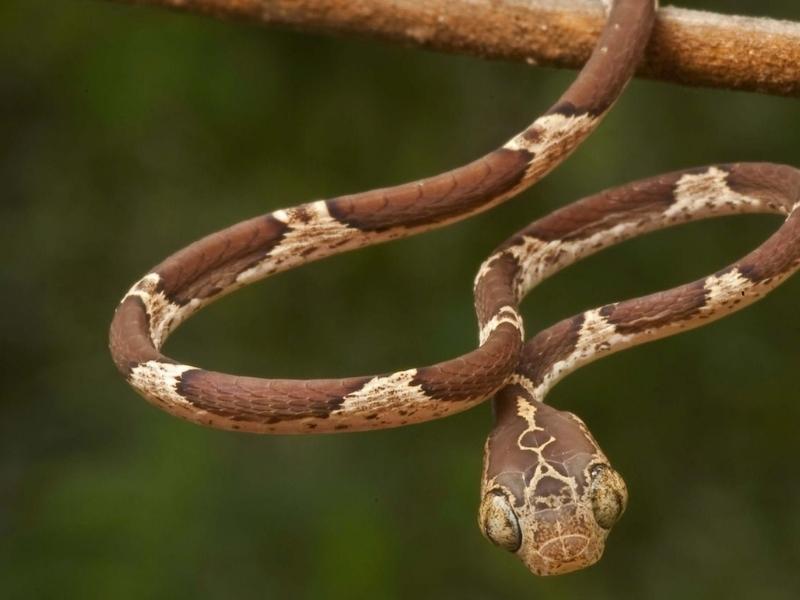
The average cost of a blunt-headed tree snake is upwards of $5,000. This species is rarely for sale online or in pet stores. Becoming part of reptile communities and searching regularly for blunt-headed tree snakes online will give you the best chance of buying a snake from a breeder.
Blunt-headed tree snakes are mildly venomous, so you should check your state’s laws on owning venomous pets before buying this species. Catching and selling a blunt-headed tree snake is legal, but be sure to buy from a reputable breeder to avoid health problems and feeding issues in the snake.
Ask to see the snake before you buy it. Check the snake has clear eyes, smooth, shiny scales, and good feeding habits. Avoid snakes with signs of poor health like red or swollen scales, cloudy eyes, and lethargy.

